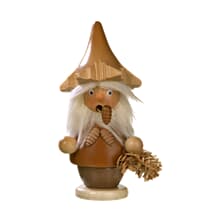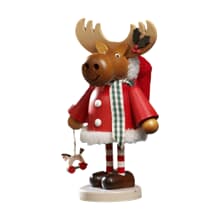Incense smokers from the Erzgebirge - precursors of modern home decor
The colder the environment, the more monotonous fragrances become in the closed living area. Since time immemorial, the only way to counter this dull feeling has been to bring smells into the home. But how should embers and smoke one day create joy in winter? The Erzgebirge folk art is still characterized by its inventiveness and humor. Thus, the miners of the region devised the ideal combination of drafts, pleasant smells and visually appealing figures during Advent and Christmas. In the meantime, numerous variations have been derived from the "Raachermannel" (High German: Räuchermännchen=Incense smokers). The spherical, sympathetically cozy little man with his smoking pipe remains undisputedly the most popular in these trends.
Incense smokers, in the Erzgebirge also established as "Raachermannel"
Incense smokers look similar to the figure of the nutcracker. On two sturdy legs bulges bulbous torso of a jovial man. From the mouth curl small clouds of smoke. But unlike the smoke from the stove or kitchen stove, the light clouds contain pleasant scents from nature, which are not otherwise present outside in winter. The pleasant smell is produced by smoldering incense candles, also called incense cones or incense candles.
With the incense smoker, the Erzgebirge folk art connects the longing of all people for lively sensory impressions in a quiet time. Nowadays, airing and sprays help against unpleasant odors in living rooms. In the earlier times, despite airing, the parlors in the Ore Mountains were filled with other smells. Especially on very cold days, the smell of smoke from the stove and fumes from the kitchen stove hung practically everywhere in the beams and brickwork. Even in the summer, this could only be partially remedied.
But this was not the only reason for the invention of smokers. They were originally purely visually the pandon to the austere figure of the nutcracker. unfortunately, the idea has not been handed down. But certainly, to this day the Erzgebirge folk art contains enough humor for grandpas with smoking pipe. Even laws against tobacco consumption worldwide can't change that. After all, the little cloud from the mouth of the Raachermannel contains no nicotine.
Religious use of incense smokers
Since time immemorial, leaders of their community have tried to replace the bad smells of winter. Pagan customs were either demonized or adopted as the Christian religion flourished. Lucky for the incense smoker! For the fragrance from his wooden mouth was an inspiration even to strict church fathers. They walked through the rows of churchgoers with incense. Since time immemorial, this has been part of the ceremonies of certain forms of church services.
However, church services do not exist every day. Thus, the Erzgebirge folk art devised a substitute that has a similar positive effect on people's minds around the clock. For a long time now, Raachermannel (incense smokers) have not only stood in the Erzgebirge at the window, on the dresser or on the Advent table. Rather, the pretty wooden figures are popular room decorations throughout Germany, Europe and other continents.
Even without religious intent, people feel the beneficial effects of incense. Subconsciously, the smells of wood or citrus fruits, of resin or lavender awaken the joy of the upcoming "bright season". Thus, the inventors of the smoking men bring confidence into all parlors - not only at Christmas time. Because in the meantime, a distinction must be made between Raachermannel and incense smoker. After all, from the idea of combining a light breeze and cozy smoke curls, many other accessories can be created, such as a smokehouse.
Wood and embers combined in a fire safe way
The challenge in using incense smokers is the fire-hazardous combination of embers and wood. For this, the inventors of the cozy smokers have found a simple solution. On the base (i.e. the underside of the belly of the smoking man) there is almost always a small metal plate. On it the incense candle can glow without problems. The heat development downwards is stopped. Upwards and to the side, the incense remains cool enough not to harm the figure.
Smoking men and incense candles still belong together for the Erzgebirge folk art. Thus, many scent mixtures are put together by the manufactures themselves. Other manufacturers in the Erzgebirge are almost completely specialized in the creation and composition of fragrances for the Christmas figure. Admittedly, nowadays there are plenty of scent experiences from sticks, spray cans, from jars or from scented trees. The incense smoker, however, remains the undisputed favorite for indoor scent enhancement during Advent.
It can happen that a smoking manikin cools down after a short time. A simple method helps against this. The top is removed until the incense candle glows visibly again. Then the figure is put together again. If the cooling happens regularly, a different placement can remedy the deficiency. Or the upper body is only partially pinned. Thus, the incense candles get a little more oxygen and will finish glowing as desired.
Modern variations of incense smokers
The incense smoker was for centuries an ingenious idea of inventive craftsmen in the then "Miriquidi" (dark forest as a historical synonym for the Erzgebirge). Nowadays, this Erzgebirge folk art offers many other variations, such as the Smoking Man as a snowman, as an elf, as a mini elf or as Santa Claus. Thus, figurative representations are not limited to people or fantasy figures. As with other forms of this beautiful craft, imagination and technical possibilities determine the modern variety.
Despite a lot of winter with a lot of darkness, wood and monotony, the Erzgebirge alone is full of inspiration for the sophisticated wood art. Thus, the historical smoking figure gets competition from funny edge stools. These do not smoke standing up, but from the ledge with dangling fabric legs. The template for new creations is everyday life in all its wintry details, for example, with a smokehouse or smoke house. Smoke is now coming out of a fireplace, from the chimney of a gingerbread house, or even from the mouths of snowmen on sleds.
Like the nutcracker, the incense smoker still represents popular professions or unloved stands. A forester or night watchman, Santa Claus or his little helpers, the elves, and a snowman cozily smoke around each other. Toy sellers or wine merchants can be found among the inventiveness of the manufactures. The main feature of an original handicraft is always its uniqueness. Besides carving and turning art, painting also gives the figure its individuality. One thing further distinguishes Raachermannel from machine copies. If it is made in a manufactory, it is guaranteed to have seen only hand tools instead of punching tools and only handicraft instead of assembly line.
Conclusion:
Incense smokers are part of the Christmas culture not only in religious regions, but now beyond German borders. With them, the Erzgebirge folk art brings German handicrafts and lovingly selected fragrance creations all over the world. It is true that incense smokers are now also manufactured by machine. But the manufactory ideas from the Erzgebirge successfully maintain their place in the Advent and Christmas season thanks to their wooden art.


































